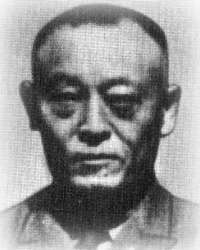Naomasa Sakonju
| Naomasa Sakonju | |
|---|---|
 | |
| Born |
June 6, 1890 Kagoshima Prefecture, Japan |
| Died |
January 21, 1948 (aged 57)[1] Hong Kong |
| Allegiance |
|
| Service/ |
|
| Years of service | 1912–1945 |
| Rank | Vice Admiral |
| Commands held | Cruiser Division 16 |
| Battles/wars | World War II |
Naomasa Sakonju (左近允 尚正 Sakonjō Naomasa, 6 June 1890 – 21 January 1948) was an admiral in the Imperial Japanese Navy in World War II.
Biography
A native of Kagoshima Prefecture, Sakonju was a graduate of the 40th class of the Imperial Japanese Navy Academy in 1912, placing 98th in a class of 144. He served his midshipman tour on the cruiser Soya, and battleship Suwo, and after commissioning as an ensign was assigned to Hashidate.
As a sub-lieutenant he served on the Kasuga, Niitaka, Azuma, and destroyer Harukaze.
After his promotion to lieutenant on 1 December 1919, he was assigned to the Tenryū, served a year as communications officer on Chichijima in the Ogasawara Islands, and returned to serve as communications officer on Mutsu, and seaplane tender Wakamiya. He was promoted to lieutenant commander in 1930, and was executive officer of the Kako in 1933. He held numerous staff positions thereafter, including that of naval attaché to Thailand from 1 September 1941.
He was promoted to rear admiral on 15 October 1941, and continued to remain in Thailand until June 1942.
He was assigned as commanding officer of the Cruiser Division 16 in September 1942, with the heavy cruiser Aoba as his flagship. CruDiv16 played an important role during many naval battles of World War II.
In March 1944, CruDiv 16 was engaged in raiding Allied shipping between Aden and Fremantle. The 6,100-ton British steamer MV Behar, crewed mostly by Indian seamen, was sunk about midway between Ceylon and Fremantle on 9 March 1944. Following this attack, the squadron broke off its mission and returned to Batavia, as it was feared that Allied ships responding to the Behar's distress signal posed an unacceptable risk. The cruiser Tone took 114 survivors aboard. Admiral Sakonju directed that the prisoners should be "disposed of". Captain Haruo Mayuzumi on Tone requested clarification, at sea and again at anchor off Batavia. Sakonju again ordered that the prisoners should be eliminated, except for any specialists of intelligence value. Mayuzumi carried out the order at sea during the night. Those killed included 10 of 14 officers on the MV Behar, and most of the Indian and British crew.[2]
Promoted to vice admiral on 15 October 1944, Sakonju became chief of staff of the China Area Fleet, remaining in that post until the war's end in 1945.
In 1946, Sakonju was arrested by the American occupation authorities and extradited to Hong Kong, where he was charged with war crimes by a British military tribunal over his role in the murder of the survivors of the Behar. Captain Mayuzumi was charged alongside him. Sakonju took responsibility in his 1947 affidavit. "In view of the fact that the Allies are lately killing Japanese prisoners of war at Guadalcanal by running tanks over them and are often bombing and torpedoing Japanese hospital ships, causing many casualties, the H.Q. came to a conclusion that the Allies are aiming at the reduction of Japan's manpower, and H.Q. decided to retaliate."[3] Mayuzumi received a seven year prison sentence. Sakonju was sentenced to death, and hanged in January 1948.[4]
References
Books
- Benninghof, Mike (2005). Japan's Floatplane Cruisers. New York: Avalanche Press. ISBN 0-7858-0437-4.
- Dupuy, Trevor N (1992). Harper Encyclopedia of Military Biography. New York: HarperCollins. ISBN 0-7858-0437-4.
- Morison, Samuel Eliot (2001). Leyte: June 1944-January 1945 (History of United States Naval Operations in World War II, Volume 12). Castle Books. ISBN 0-7858-1313-6.
- Vandervat, Dan (1992). Pacific Campaign: The U.S.-Japanese Naval War 1941-1945. Simon & Schuster. ISBN 0-671-79217-2.
External links
- Nishida, Hiroshi. "Imperial Japanese Navy". Retrieved 2007-08-25.
Notes
- ↑ Nishida, Imperial Japanese Navy
- ↑ Russell, Knights of Bushido London 1958, 1989 pp182-5
- ↑ Mike Benninghof. "Japan's Floatplane Cruisers (excerpt)".
- ↑ "Jap rear-admiral hanged for war crimes". The Argus. 23 January 1948.